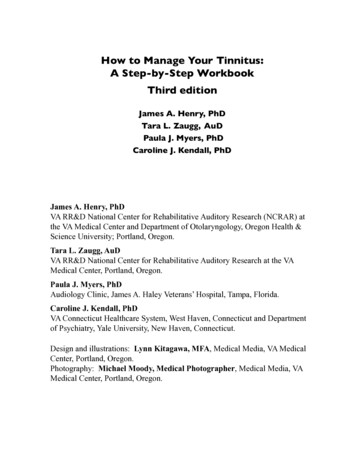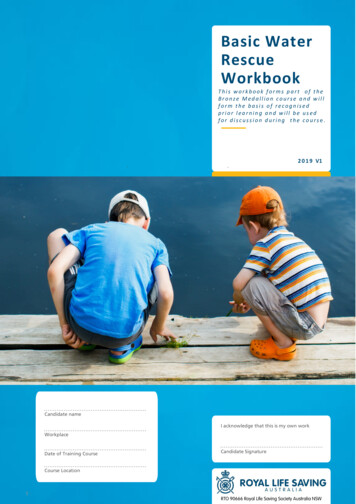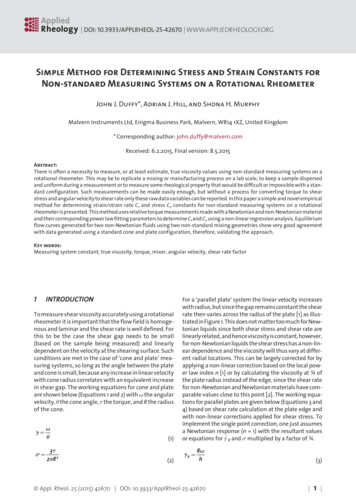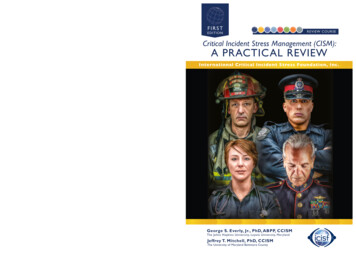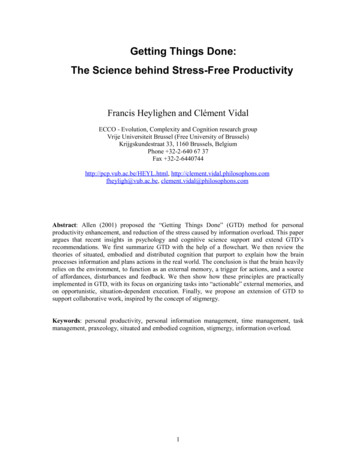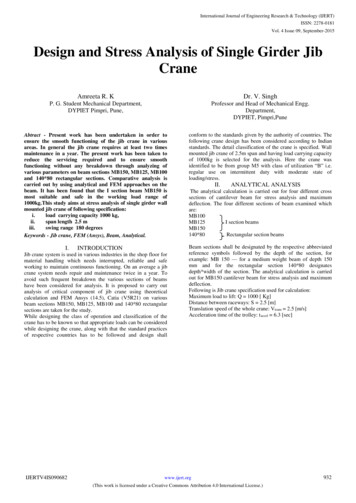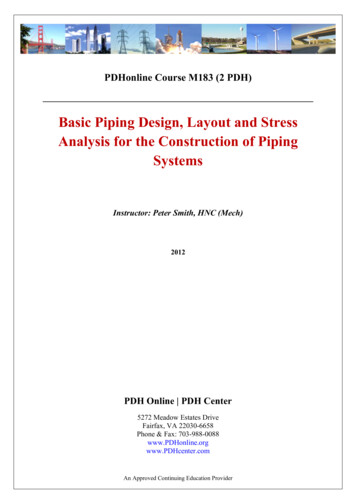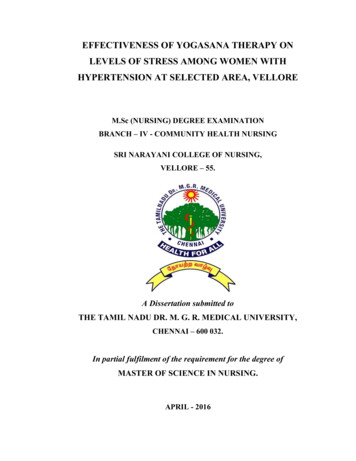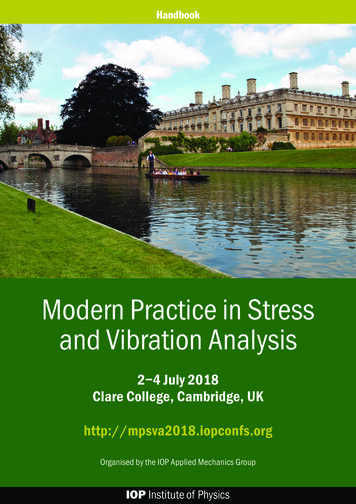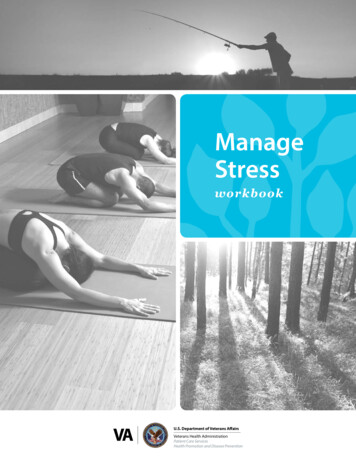
Transcription
ManageStressworkbookU.S. Department of Veterans AffairsVeterans Health AdministrationPatient Care ServicesHealth Promotion and Disease Prevention
ContentsStress Goal . . . . . . . . . . . . . . . . . . . . . . . . . . . . . . . . . 1This workbook was designed by the NationalCenter for Health Promotion and DiseasePrevention (NCP). It will guide you throughsteps to identify and track your stress, andpractice a variety of strategies that have beenshown to counteract stress.It goes without saying that you have probablyexperienced periods of high stress and danger.You probably are well acquainted with the‘fight or flight’ feeling that often occurs in suchsituations. This heightened feeling occurs whenour bodies release stress hormones in responseto the stress. The hormones keep us alert andready to deal with whatever is happening or isabout to happen.While this natural response serves us well inthe short term, our bodies need time to recover.Prolonged, high stress can cause high bloodpressure, a weakened immune system, heartdisease, and digestive problems. Headaches,Keys to Managing Your Stress . . . . . . . . . . . . . . . 24Mindfulness . . . . . . . . . . . . . . . . . . . . . . . . . . . . . . . 7Other Factors for Managing Stress . . . . . . . . . . 13Appendix A: My Health Choices . . . . . . . . . . . . . 15Appendix B: Pleasant Activities Tip Sheet . . . . . 17Tools for Managing Stress . . . . . . . . . . . . . . . . . .depression, aggressive behavior, and low energyare other common symptoms.You can learn specific techniques for managingyour stress more effectively. These techniquescan help you lower your stress and improveyour readiness to respond in stressfulsituations. You’ll also deal more easily withstress when it comes up.It’s important to remember that you cannotalways control the causes of your stress, but youcan control the way you react to the stress.Stress Management GoalThis workbook chapter is designed for you to use on your own. However, if you feel stuck, orwould like help with this, feel free to contact your primary care/PACT team. There are staff on theteam, including the Health Behavior Coordinator, who are experienced in helping with this kind ofgoal-setting.Be sure that the goal you set is SMART (Specific, Measurable, Action-oriented, Realistic,Time-based). You may find the My Health Choices worksheet in Appendix A helpful.Suggested goal: On a scale of 0–10, where 0 means not bothersome, 5 means somewhatbothersome, and 10 means very bothersome, my goal is to have my average stress level bebelowfordays a week.My stress management goal is:·1·
Keys to Managing Your Stress➊➋Track Your StressStress affects everybody differently. By regularly monitoringand tracking your stress, you raise your awareness of theway you experience stress and get a better sense of yournatural stress level. Knowing how your body reacts to stresswill help alert you when your stress level is rising.Track your stress levelsusing the Stress Trackeron page 4.Identify the Sources of Your StressActivity:Knowing the sources of your stress is critical. After you havea good idea of the things that cause your stress, you candevelop a plan for dealing with each of them.➌Mindfulness-Based Stress Reduction (MBSR) techniqueshave been proven to reduce stress and stress-relatedconditions in Veterans. They can reduce anxiety, improveattention and memory, and help manage chronic pain.These techniques center on being fully aware in the presentmoment without judgment.Be Physically ActivePhysical activity is one of the most effective stressmanagement techniques. Physical activity increasesendorphins, improves sleep, raises self-esteem, and releasesmuscle tension.·2·Make a list of the thingsthat cause your stress.Use the Identifying YourStressors Worksheet onpage 5 for ideas.Practice Mindfulness RegularlyMindfulness is a way to be fully aware in the presentmoment of physical sensations, emotions, and thoughts,but without judging them. Regular daily practice of stressmanagement techniques will allow you to deal with yourstress in a healthier way.➍Activity:While moderate physical activity is good for stressmanagement, overly vigorous activity can actuallycontribute to stress levels. If you are going to exerciseto help relieve stress, do so at an intensity level that iscomfortable for you.Activity:Review the StressSymptoms Checkliston page 6. Explore theMBSR Techniques onpage 7 to determinewhich are most effectivefor managing the stresssymptoms you identified.Find moreinformation:in the Be PhysicallyActive Healthy Livingmessage at http://www.prevention.va.gov.Regular physical activitycan improve mood,reduce stress, anddecrease health risks.
➎Practice Deep BreathingActivity:It’s one of the fastest ways to deal with stress in themoment. Use deep breathing to gain control over stress,anxiety, and panic. It is also effective for managingdepression and emotional responses, and can even behelpful for some medical conditions.The next time you rateyour stress level to bea 7 or higher, practicedeep breathing toimmediately lower yourstress level.The more you practice, the better you will become atmanaging stressful situations.➏ Plan Pleasant ActivitiesResearch has shown that the things we do affect the waywe feel. When you spend time in activities that you findrelaxing, enjoyable, or just plain fun, you tend to feel lessdistressed and happier.For many people, life demands seem to replace pleasantactivities. If you notice this happening to you, it’s time toplan for positive time.Activity:Actions affect emotions.Plan a pleasant activityusing the PleasantActivities Tip Sheet inAppendix B for ideas.Deep Breathing ExerciseDeep breathing is one of the fastest ways that you can regain control over stress.1. Start by sitting down in a comfortable placethat’s free from distraction. Uncross your legs,put both feet on the floor, and rest your handsin your lap. Pay attention to how this positionfeels and let your mind and body just “be” fora few moments.2. Close your eyes and notice the pattern of yourbreath as you inhale and exhale. It may besoft or loud, slow or quick, or shallow or deep.Make a mental note of your breath beforeyou start relaxing with deep breathing. Justbreathe naturally for a few moments, takingslow and deep breaths in through your noseand then breathing out through your mouth.3. Now hold your breath for 5 seconds after youinhale, and for another 5 seconds after youexhale. Continue breathing in this rhythm fora few moments.4. Breathe naturally for a moment. Now placeboth of your hands on top of your stomachand try to notice how your belly rises witheach inhale and falls with each exhale. Noticeyour breath moving in and out again from yourbelly, to your chest, and gently out throughyour mouth. Continue breathing naturally.5. This time say, “Relax” silently or aloud aftereach time you exhale.6. Repeat this exercise for 1 to 5 minutes.·3·
Tools for Managing StressSTRESS TRACKERRate your stress level regularly by choosing a number between o-10, where1 means not bothersome, 5 means somewhat bothersome, and 10 means verybothersome. Tracking your stress will help you identify patterns in your stress.Stress RULER“On a scale of 0 – 10, how bothersome has your stress been?”01Not at AllBothersome23A LittleBothersome456SomewhatBothersome78910Very ExtremelyBothersome BothersomeWhen you notice your stress rising, you should practice your favoritestress management techniques before your stress levels get too high.Date & Time·4·Stress Level(0–10)What was I doing?What was I thinking?
IDENTIFYING YOUR STRESSORS worksheetUse this tool to list your stressors. For each item on the list, mark whether or not it is important toyou and whether or not you have control over it.You might also try to avoid these stressors or limit exposure to them. If you can’t avoid dealing withthem, practicing deep breathing when you interact with them might limit your stress response.Changing Jobs/PromotionMoney WorriesTravel/Vacation/HolidaysConflict With FamilyPain/FatigueUpcoming WeddingKeeping HealthyPlanning for RetirementGlobal WarmingLack of ConfidencePublic SpeakingWorld EconomyLonelinessTraffic to/from WorkWar/TerrorismOther:Now, review your list of stressors and, for each one, ask: Is this important to me? Is this under my control?List each of your stressors in the appropriate box below:ImportantNot ImportantControlDo NotControl Let go of the stressors that you identified as not important. They aren’t worth the stress they cause. Take some time to address those stressors that you feel are important and that you do have at leastsome control over. Practice stress management techniques for the stressors that are important but that you do notcontrol. You might also avoid these stressors or limit exposure to them.·5·
STRESS SYMPTOMS checklistWhen you know how your body responds to stressors, you can focus yourattention on finding the best stress management technique for each one. Checkoff the symptoms you experience when you’re feeling a lot of stress.BackacheMuscle Cramps/SpasmsLack of MotivationChange in Sex DriveNeck & Shoulder PainLonelinessChest PainPainSadness or DepressionChest TightnessSleep ProblemsCryingDigestive IssuesSmokingEating When Not HungryGeneral Muscle TensionTeeth GrindingFrustrationHeadacheUpset Stomach/NauseaIrritability/AngerHeart nxietyWorryingLack of EnergyForgetfulnessOther:NOTE: Some of these symptoms can indicate a medical problem rather thanstress. If you are experiencing any unusual symptoms or symptoms that aresevere enough to prevent you from engaging in your daily activities, contactyour healthcare team right away.·6·
MindfulnessMindfulness-Based StressReduction Techniques Mindfulness MeditationThe intention of Mindfulness Meditation isto be fully aware of what is going on in thepresent moment without any judgment. Compassion MeditationThis meditation can lower stress and stresshormone levels and raise self-esteem. Youcan improve self-compassion by workingon unhelpful thoughts and by practicingthis meditation. Body Scan MeditationThis meditation is deeply relaxing and canhelp you become more accepting of areas ofpain or discomfort. Mindful Eating ExerciseThis exercise helps you to practicemindfulness with something you do everyday: eating. You will learn how to increaseyour awareness while eating, which canincrease mindfulness and improve youreating habits overall.Mindfulness MeditationTo anchor yourself in the present, focuson your breath as you inhale and exhale.Breathing mindfully does not involve aconscious changing of your breath.1. Set aside a 1 to 5 minute period of time, andtell yourself that you will not engage yourthoughts during that time. As thoughts popup, just notice them and let them go.2. As you notice your mind thinking aboutthings, try to let those thoughts go withoutjudging them and return your attention tothe experience of breathing. The point isnot to stop having thoughts. The point ofthis meditation is to become more awareof your thoughts without automaticallyengaging them.If focusing on your breath does not work tobring you into the present moment, you canfocus on anything in the present, such assounds, a picture you like, or a candle flame,so long as you don’t have to think about it. Progressive Muscle RelaxationThis exercise can help you become aware ofmuscle tension, so you can release it whenneeded. Mindfulness CircleThis image will help you return to mindfulawareness throughout your day.If you find these techniques helpful, you canspeak with your primary care/PACT team tofind stress management programs that mightbe available in your area.·7·
Compassion MeditationBody Scan Meditation1. First, take a few deep, cleansing breaths andground yourself in the present.The Body Scan Meditation can help youbecome more accepting of areas of pain ordiscomfort and not tense in response to them,which can make the discomfort worse.2. As you breathe deeply, focus on yourheart and visualize softness, warmth, andcompassion glowing in your chest. Repeatthese phrases to yourself: “May I be happy.May I be well. May I be safe. May I bepeaceful and at ease.”3. After a minute or two, visualize extendingthis energy to include somebody you caredeeply about. Now repeat the phrases, fillingin the person’s name. For example, “May mywife be happy. May my wife be well. Maymy wife . . . .”4. Next, visualize extending the energy tosomebody you feel neutrally about. Repeat thephrases with his or her name. For example,“May the cashier at the store be happy. Maythe cashier be well. May the cashier . . . .”5. Now extend the energy to somebody forwhom you have negative feelings. Repeat thephrases with his or her name.6. Finally, visualize extending this energy to therest of the world.As you become comfortable with this practice,try extending the length of time you spend ateach stage, increasing the overall time spent onthe meditation.To practice the Body Scan Meditation, get into acomfortable position. You might lie down on thefloor or in bed with a pillow under your head.Take a few deep, grounding breaths and gentlybring your awareness to the present.1. Pay attention to a specific body part, such asyour left foot. As you breathe deeply, scanthat part of your body for sensations. Noticethe sensations you feel, but try not to get lostin thought. Gradually let your focus move todifferent body parts — each leg, your hips,stomach, chest, hands, arms, and head.2. Practice mindfulness meditation with yourfocus on your body. Become aware of yourmind’s tendency to get lost in thought.When you notice this happening, just let thethought go and gently redirect your attentionback to your body. Try not to engage in thecontent of the thoughts.If you have any pain or discomfort, just noticeit, accept it, and continue scanning. Continue toscan each part of your body in this way until youhave scanned your whole body.Dealing With Distractions During MeditationThe purpose of meditation is not to concentrateon your breath or to achieve a perfectly still andserene mind. The goal of meditation is to achieveuninterrupted mindfulness.Being distracted is normal; it’s how our mindswork. When you sit down to concentrate on yourbreath, don’t be upset when your mind wandersfrom the subject of meditation. Instead, simplyobserve the distraction mindfully.·8·Whenever you are distracted away from your breathas you meditate, briefly switch your attention to thedistraction. Make the distraction a temporary objectof meditation, but only temporary. Your breathshould remain your primary focus.Switch your attention to the distraction only longenough to notice certain things about it. What isit? How strong is it? How long does it last? Returnyour attention to your breath as soon as you havewordlessly answered these questions.The first step to changing something is seeing itthe way it really is — these questions can free youfrom what is distracting you and give you insight
Mindful Eating ExerciseMindful eating is an ongoing practice, but it starts with three simple steps.1. Become aware of the physical characteristicsof food. Make each bite a mindful bite. Thinkof your mouth as being a magnifying glass,able to zoom in. Imagine magnifying eachbite 100%. Pay close attention to your senses.Use your tongue to feel the texture of yourfood and to gauge the temperature. Take awhiff of the aroma. Ask yourself, “How doesit really taste? What does it feel like in mymouth? Is this something I really want?Does it satisfy my taste buds? Is my mindtruly present when I take a bite so that Iexperience it fully?”2. Become aware of repetitive habits and theprocess of eating. Notice how you eat. Fast?Slow? Do you put your fork down betweenbites? Are you stuck in any mindless habits,such as eating a snack at the same time eachday, multi-tasking while you eat, or eatingthe same foods over and over again?3. Become aware of mindless eating triggers.Look for specific cues that prompt you tostart and stop eating. Is your kitchen a hotspot for snacking? Do feelings such as stress,discomfort, or boredom lead to a food binge?Do judgmental thoughts like “I’m an idiot!”trigger mindless eating?Become an expert on the emotional buttons thattrigger you to eat when you aren’t physicallyhungry. When you know your triggers, you cananticipate and respond to them.Ask yourself, “What am I feeling right beforeI mindlessly snack? Is my environment,emotional state, or dining companion helpingor hurting my efforts to eat wisely?”See the Eat Wisely Healthy Living messageat http://www.prevention.va.gov for moreinformation on nutrition.Ask yourself the following questions: “Do Ihave any ingrained habits concerning how Isnack? When I pick up my fork, what standsin the way of eating wisely?”into its nature. It’s important to tune into thedistraction without getting stuck on it.it mindfully and wordlessly. When you do, it willfade by itself.When you begin using this technique, you willprobably have to do it with words. Ask yourquestions in words and answer in words. Soonyou will be able to dispense with the use of wordsaltogether. As the mental habits are established,you will be able to simply note the distraction, notethe qualities of the distraction, and then returnyour focus to your breath.Don’t fight your distracting thoughts, even if theyhave popped up before. Any energy you givetoward resistance makes the distraction that muchstronger. Just observe your distractions mindfully,and return your focus to your breathing. Refuse tofeed your distractions with your own fear, anger,and greed, and they will eventually go away.A distraction can be anything: a sound, a sensation,an emotion, a fantasy. Whatever it is, don’t try torepress it or force it out of your mind. Just observeBe patient and persistent. While mindfulnessdisarms distractions, it may take many times tobreak the hold of deep-seated thought patterns.·9·
Progressive Muscle RelaxationMindfulness CircleProgressive Muscle Relaxation exerciseswill help you recognize when your musclesare tense and teach you how to return yourmuscles to a relaxed state.Mindfulness practice doesn’t have to be limitedto focusing on your breath. You can do almostanything mindfully. Try practicing mindfulnesswith one of the activities below or one of yourown. Be aware of your breath, senses, thoughts,and feelings as you perform the activity.Consider your posture, your mood, how quicklyyou move, what is going on around you, andyour level of tension.1. Breathe normally and let your body just ‘be’.Take note of how your body feels from yourtoes to your head. Does any of your body feeltense, stiff, or achy?2. Close your eyes and notice how your toesfeel. Tightly curl your toes to the point whereyou feel tension, as if trying to squeeze asmall ball between your toes and the ball ofyour feet. Hold this toe curl for 10 seconds.Release your curl and let your toes spread.Notice how your toes feel when they are freefrom tension.3. Next, repeat this cycle of tensing and relaxingwith your calves. Next, do your thighs. Moveup the body. Repeat with your hands, thenarms, and then the muscles of your upperback and shoulders. Finally, tense and relaxyour neck and face.Try being mindful while doing these everydayactions: Washing hands. Stopping at a red light. Looking at a clock or your watch. Washing dishes. Brushing your teeth. Taking a shower. Dressing and undressing. Walking.4. After you complete tensing and relaxingeach muscle in the body, breathe inthrough your nose and hold your breath for5 seconds. Slowly and gently breathe outthrough your mouth. Open your eyes andnotice how your muscles — your feet, calves,thighs, fists, arms, upper back, neck, andface — feel when relaxed.FOCUS: You begin byfocusing your attentionon something simple,such as your breath.Experience your breathin the present moment.REDIRECTION:Gently bring yourDISTRACTION:At some point, youwill be distractedby a thought, asound, a physicalsensation, etc.attention back tothe present momentby focusing on yourbreath again.AWARENESS: Next,you become awarethat you are distracted.Do not give up at thispoint. Just notice thedistraction withoutgetting caught up in it.· 10 ·
Mindfulness and FeelingsYou can achieve greater emotional intelligence and stability byusing the RAIN (Recognize, Accept, Investigate, Non-Identify)approach to your feelings.RecognizeNon-Identify Acknowledge what is happening in the bodyand in the mind. Feelings are like weather patterns. They ariseand pass. They are not you. They are not youridentity. They do not define you. What is going on here? In a compassionate, mindful way, notice whatis going on when you feel this feeling. Experience and recognize the pure essence ofthe feeling.Accept What is, is. Feel what you feel. The stream of feelings is always with us. This stream of feelings is ever changing andhas pleasant, unpleasant, and neutral tones. Accept what you feel. Remember, what we resist, persists.Investigate Look into the feeling closely. Study the feeling. Notice how it feels in the body. Does it have a sensation of movement, oftemperature, of density, or of color? What is the energy of the feeling like? Recognize the universal nature of the feeling:“Right now I am feeling this, and thereare many other people just like me feelingthis. Many who have come before me havefelt this feeling and many who will comeafter me will feel this feeling. This is ahuman feeling.” “Breathing in, I am awareI feel. Breathing out, I meetmyself with compassion.”As you get to know your feelings, you willdevelop a natural wisdom and insight intowhich feelings you need to let be, which requireaction, and which will cause more suffering ifyou act on them.Sometimes you gain insight into the root of thefeeling which will enable you to take a differentapproach to the moment or situation. Othertimes you may observe the feeling, but donot want to continue fueling the feeling withthought and energy. What stories go along with this feeling? Is there a particular time of day when thisfeeling surfaces? Does anything immediately precede the arrivalof this feeling? How long does the feeling last? How do youfeel after the feeling has passed?· 11 ·
MINDFULNESS HOMEWORKExperiment with mindfulness. Try to bringyourself fully into the present to experienceeach situation. Do no more than one of theseexperiments each week. For example, for oneweek, see if you can bring mindful attentionto pleasant events. In a different week, trybringing mindful attention to negative events,and so forth.Pleasant Communication ReportPleasant Event Report What did the other person(s) want? What didthey actually get? Be aware of one pleasant event or occurrencewhile it is happening at least once this week,paying attention to the sensations in the body,thoughts, and feelings. With whom? What subject? Were you aware of pleasant feelings duringthe communication? What did you really want from the person orsituation? What did you actually get? What thoughts accompanied this eventat the time? What was the experience? What emotions accompanied this eventat the time? How did your body feel? In detail, describethe sensations you felt.Unpleasant Communication Report What thoughts accompanied this eventat the time? Record one unpleasant communication event.Describe the communication. What emotions accompanied this eventat the time? With whom? What subject?Unpleasant Event Report Be aware of one unpleasant event oroccurrence while it happens at least once thisweek. Pay attention to the physical sensations,thoughts, and feelings that arise at the time ofthe experience. What was the experience? How did your body feel? In detail, describethe sensations you felt. What thoughts accompanied this eventat the time? What emotions accompanied this eventat the time?· 12 · Record one pleasant communication event.Describe the communication. How did the difficulty arise? Were you aware of the unpleasant feelingsduring the communication? What did you really want from the person orsituation? What did you actually get? What did the other person(s) want? What didthey actually get? What thoughts accompanied this eventat the time? What emotions accompanied this eventat the time?
Other Factors for Managing StressAligning Your Core ValuesLosing track of your core values can contribute tounhealthy stress levels. Think about what reallymatters to you in your life. Spending time doingwhat is important to you can reduce stress andgive you energy. Filling out a Personal HealthInventory can help you explore all areas of yourlife. Talk to your health care team or go to theHealth for Life* website for more information.Problem SolvingMindfulness practice helps you to slowdown and become more aware of options.Mindfulness fosters flexibility, which can beessential for problem solving. Mindfulnessalso can help you assess how you feel about thevarious options and make an educated decisionabout the next best step.When you face a difficult problem, begin bygrounding yourself with mindful breathing. Next,visualize the problem without getting attachedto finding solutions; just breathe and be awareof the issue. Allow solutions to come and go — jotdown any that seem useful — and then come backto the meditation. As solutions emerge, take amoment to see how each one feels, noticing ifone seems more right than another.Developing ResilienceResilience refers to a person’s ability towithstand and bounce back from difficultsituations. Mindfulness helps you reducestress, which in turn increases your resilience.Mindfulness enables you to be better able to stepback and assess situations from a calm place andultimately to adapt to the present moment.Positive coping involves doing things thatkeep your body and mind healthy and strong.Coping in healthy ways builds your resilience.Mindfulness is one form of healthy copingthat builds your resilience. Getting enoughrest and sleep, planning your days, stayingphysically active, eating healthy foods, andhaving supportive people in your life alsobuild your resilience. Building your resiliencehelps you cope with stress in a healthier way.Positive coping, or dealing with stress well,leads to making better decisions, figuring outsafe ways to solve problems, and loweringyour chances of developing health problemslike high blood pressure and depression.Positive coping even helps you deal better withphysical and emotional pain, manage yourweight, sleep better, and be calmer when instressful situations, such as driving or being incrowded places.Eating Wisely When StressedWhen we feel stressed, we tend to make poorfood choices such as skipping meals andchoosing less healthy, convenient options likefast food and processed foods. Such choices arepartly due to high levels of stress hormones,which cause us to crave fat and sugar.Unfortunately, eating lots of junk food andsugar and skipping meals actually createsphysical stress for our bodies that adds to ouroverall stress load. When we choose healthierfoods that are high in nutrients, our ability tohandle stress improves because we’ve removedone source of physical stress from our lives. Askyour primary care team about a healthy eatingplan and mindful eating, which have beenshown to help reduce overeating and improveweight loss results.See the Eat Wisely Healthy Living messageat http://www.prevention.va.gov formore information on nutrition.* Also see the Health for Life website at:http://healthforlife.vacloud.us· 13 ·
Changing Unhelpful ThoughtsHabitual, negative thoughts can contribute tostress as well as perpetuate negative behaviors.Mindfulness can help you be more aware ofyour unhelpful thought patterns so you canreplace them with thoughts that support yourgoals. Mindfulness helps you to get into thepresent to make the necessary changes.Getting Social SupportHaving social support is an importantcomponent for stress management. It isimportant to have the support of other Veteransand people who know what it has been like.communication patterns and improvecommunication with difficult people.Working With Chronic PainBeing mindful can help you manage chronicpain, whether it is physical or emotional. Manypeople physically tighten up in response to painor otherwise resist it. Resisting your feelingsof pain creates another layer of distress andmakes the suffering worse. You can lessen yoursuffering, possibly even get rid of it altogether,by eliminating your resistance to pain. Becausepain is both real and inevitable, it’s important toaccept it.Increasing Self-CompassionActivity:Self-compassion is the ability to be forgivingof yourself. Low self-compassion can increasestress levels and stress hormone levels whilelowering self-esteem. You can improve selfcompassion by working on unhelpful thoughtsand by practicing compassion meditation.If you are experiencing pain or discomfort,use the Body Scan Meditation on page 8 tobecome more aware of any resistance youmay be having to your pain that can actuallymake your discomfort worse.If you are experiencing unusually severe pain,you should talk to your healthcare team about it.Activity:Practice the Compassion Meditation on page 8.Managing Interpersonal StressYou can lower stress by practicing mindfulcommunication. This includes saying whatyou really mean as well as mindful listening.It will increase your awareness of unhelpfulYou should contact your healthcare team or theVA Crisis Hotline at 1-800-273-8255 (Press 1)if your stress seems to be getting out of controlor you are having thoughts of harming yourselfor others.You can always reach out to your primary care/Patient Aligned Care Team (PACT) for help.Notes· 14 ·
Appendix ASMMy Health Choi
ready to deal with whatever is happening or is about to happen. While this natural response serves us well in the short term, our bodies need time to recover. Prolonged, high stress can cause high blood pressure, a weakened immune system, heart disease,
